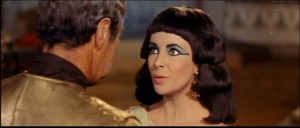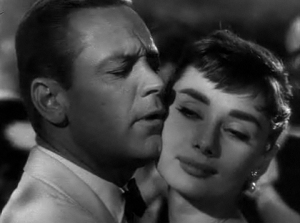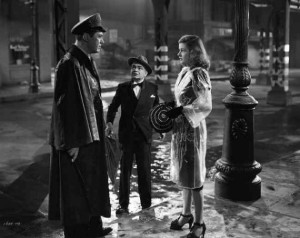The Movie Love Triangle
The number three (3): It’s not just holy (Trinity), the tres is a basic element in life’s periodic table of circumstance. It’s found almost as often as carbon, chlorophyll and car chase scenes. Alot more fun than the number one but without all that pressure that can come with two.
What has three sides, fills with equal parts love, hate and confusion, shakes-out quicker than you can say Jack Robinson but takes an hour to drink in its full, rich flavor? A bad banana daiquiri? Take another swig. It’s the movie love triangle!
There’s something about having three of whatever it is that makes it a force to reckon with, the third adding balance when two gets a bit wobbly (The Quiet American (58 / 02)) or necessary tension to give the ride more spring (Kelly + Reynolds + O’Connor (Singin’ In the Rain (52)).
Some notable trios:
A good place to start is the nursery rhymes in the Three Little Pigs, Three Blind Mice and Goldie Locks and the Three Bears;
The bejeweled triple crowns in baseball and horse-racing;
Three strike (MLB – 1888) and three strike rules (crime convictions = life jail);
Early 20th century trio of bear Cubs in Joe Tinker (SS), Johnny Evers (2B) and Frank Chance (1B) (hot-corner Harry Steinfeldt forever in the shadow) who were the tar & nails that held their champion-ship together;
Memorable NHL scoring threesomes in the Punch (40s Habs Toe Blake, Elmer Lach and Maurice “Rocket” Richard), the Production (post-WW2 Red Wings in Gordie Howe, Frank Mahovlich and Alex Delvecchio) and Party lines (80s Blackhawks Al Secord, Dennis Savard and Steve Larmer);
Famous film trios The Three Musketeers (35), The Three Stooges (34), Paradise for Three (38) the Three Amigos (86 (ugh)), “Tuco” – “Blondie” & “Angel-eyes (The Good, the Bad and the Ugly (66))” and The French Line with gorgeous Jane Russell, handsome Gilbert Roland and dedicated Arthur Hunnicutt (1954).
The New England championship triumvirate in current quarterback Tom Brady, head coach Bill Belichick and owner Robert Kraft.
Pop music loved the tres: The Three Degrees, Three Dog Night, songs “Knock Three Times“ and “♫ once, twice…three times a lady ♫.”
The big three Allied powers in WW2: Soviets, British and Yanks;
Our constitution-based government works its check and balance through the three branches of judiciary, legislative and executive powers.
There were the three bucks (4-6 pointers?) that showed-up in our backyard last summer just for a brief look-see.
And the tastiest lunchtime triad ever served up in the hot dog (uncured), bean soup & potato chips (mustard & pickle preferred, paper napkin a must).
The pointed passion circle is not as certain as death and taxes in life’s journey but it’s definitely in the top five, “definitely!”
A cinema staple since before the Swingline® started holding it all together, the love triangle fastens fans to their seats as sure as drama and mad-cap adventure, its popularity from the fact that the tricky triad holds a chapter in most biographies, whether you knew it or not (gulp).
But it’s on the silver screen where the crowded state of affairs takes on a curious, usually pretty interesting aura of angst.
The Hollywood pros in front and behind the camera can make almost anything look glamorous, from bad deeds (Bonnie and Clyde (67)) to something as simple as turning down bed sheets in prelude to a lustful encounter (This Sporting Life (63)). So why wouldn’t the love triangle translate too?
They began in the silents and ran strong well into the 1960s providing plots and pushing viewers to pick a side. By the polyester period (70s) the triangle had, for the most part, been shelved with the occasional re-appearance (Working Girl (88) / Titanic (97) / Amores Perros (00)), for old times sake (?).
The listing herein is not exhaustive of movie love triangles by any means, but examples of some of the worst, the best and how in spite of a terrible triangle a good time can still be had by viewers.
Three points to keep in mind: 1) There are good and there are bad L/Ts. Geometric juxtaposition is no guarantee for a good watch, unless Seiko’s keeping time; 2) The bad are not necessarily bad movies, in fact, some are good enough to keep you glued, with the tacky triad usually stemming from non-believability and a normally strong male lead (Lancaster, Mitchum, Garfield, etc.) written as a sap, and 3) Not all three sides need be of the human species, for included here is a big ape, Alien pods and even something as intangible as duty, the tangible kind found in the “Bushwood Country Club” pool (Caddyshack (80)).
The Bad Triangle
Baby Doll (56): Either kiss her (“Doll”) or cut her free, “Archie,“ but why you never gave “Silva” a swift kick in the pants I never understood.
Casablanca (42): Neck n’ neck with Citizen Kane to take vintage cinema’s Over-rated Cup (contemporary field is crowded) which explains why two of its three (+Bogart) leads in Paul Henreid and Ingrid Bergman never bought the hype. That she’d end up at his café to cheat on her Nazi-pursued husband is about as believable as Rita Hayworth a blonde (The Lady From Shanghai (47)).
Champion (49): Real-to-life in its portrayal of how brash boys (Douglas) always get the girl over the nice guys (Kennedy), buy a really, really bad boxing and babes movie. Was first big hit for film giants Stanley Kramer and Kirk while Ruth looks splendid in her white, one-piece swimsuit. And any pre-development shots of the California Pacific coast are always way, way cool.
Cleopatra (34 / 63): Don’t trust me, go ahead and watch. Pack a lunch (4h+).
Criss Cross (49): Only the marvelous mood-setting L.A. locales (Bunker Hill district, downtown, etc.) were believable.
East of Eden (55): All’s hunky-dory between “Abra (Harris)” and “Aron (Davalos)” who props his odd-ball brother “Caleb (Dean),” the later who turns their world upside down with wartime profiteering, stealing the girl’s heart, driving the jilted into the War to cause their father’s stroke. One bad triangle.
Gilda (46): Top tune (“Put the Blame On Mame”), copper Calleia at his best, Ford (fists) and Macready (cane) impress in the clutch but like Casablanca (42), former flames reuniting where they do is complete balderdash, this time down Argentina way, then add in Hayworth’s kooky choice in Nazi-sympathizer spouse (“Mundson”), all make this L/T…T/L (totally limp).
Holiday Affair (49): Cute film with judge Harry Morgan snapping off wisecracks like fireworks. A good Ajax scrub for bad-boy toker Bob Mitchum. But single-Mom Leigh dumping oxymoronic likable lawyer and long-time suitor Wendell Corey (“Carl”) for fly-by-seat-of-his-hobo-pants “Steve?” C’mon, “Connie!”
Humoresque (47): After she (Crawford) finally wins his heart and he (Garfield) finally makes up his mind, she takes the long walk into the sea of love.
It Came From Beneath the Sea (55): Shameless display of flirt and emasculation. Only wish the NMO (normal man out) Curtis (“John”) had taken the short, chain-smoking smart-ass Tobey character (“Pete”) and Howard Hughes’ girlfriend (?) Faith Domergue (“Les”) and clunked their heads together at close. So awkward even Ray Harryhausen’s typical top-tier SMA couldn’t save this bad boy…girl.
Out of the Past (47): This one is a love rectangle (square) where Jane Greer (“Moffat”) had allure in spades but like Burt Lancaster in The Killers (46) when the love-sick “Swede” practically commits suicide in letting tough guys Charles McGraw and William Conrad (“bright boy”) blow uncontested into his room to empty their revolvers, Robert Mitchum (“Bailey”) too plays the super sap.
Pal Joey (57): Even Sinatra’s voice can’t fuel this clunker.
Red Dust (32) (Mogambo (53)): Gable never runs out but adulteresses in both (Astor – Kelly) are so poorly scripted you wonder why they bothered.
Sabrina: (54) Paramount tabbed “terrific triangle” but usually sharp-as-a-tack Holden is scripted an idiot and Bogart’s bored until final smackdown.
Sleepless in Seattle (93): After respective hits When Sally Met Harry (89) and Big (88), Hanks and Ryan’s likeability ratings were higher than the Empire State Building, even as this triangulated affair (+ Bill Pullman) is too cute, too much kid (Malinger) and constitutes two too many remakes of a grand original, Love Affair (39) (See also; An Affair to Remember (57)).
Song of India (49): Triangle makes some sense (Sabu > Gail < Bey) but its resolution and laughter in final scene is preposterous…and cold.
Sunset Boulevard (50): Triangle again is believable enough (Swanson > Holden < Olson) but Bill’s bail on “Norma,” she not just a pretty face, is bogus.
The Cat People (42): French beauty Simone Simon can get catty but new hubbie Kent Smith (“Oliver Reed”) turns wolf with ‘friend’ “Alice (Randolph)” before honeymoon ends, leading this viewer hoping the feline feasts.
The Graduate (69): Mommie Dearest and vampish motives aside, “Benjamin (Hoffman)” was in clover with the “Mrs. (Bancroft)” but then got greedy to graze in posted pasture (Ross) to turn pathetic post-grad.
The Las Vegas Story: A marriage on the brink (Price + Russell) pushed over by an ex-lover (Mature) who investigates the husband. Guess who wins?
The Pace that Thrills (52): Vintage, daring motorcycle footage in neato-keeno but once again the bad boy (Williams) gets the gal (Carla Balenda).
The Painted Veil (34): Nice ending but Brent’s advances on Garbo feel forced. A build up to the love from happenstance would‘ve worked fine.
The Philadelphia Story (40): Kate’s not that likeable, harebrained haughty we loved so in Bringing Up Baby (38). She’s the other kind.
The Postman Always Rings Twice (46): Garfield plays out of his typical, strong, savvy persona into another unbelievable L/T super sucker for a fairly typical, scheming blonde (Turner). The ‘Crime Never Pay’s’ road-sign is posted early and makes for a long, painful drive (113m) on Sleeper Highway.
Two Guys From Milwaukee (46): Fun movie turns uncomfortable when once likable “Prince Henry (Dennis Morgan)” turns hound-dog (cad), made worse when the lady on point, Joan Leslie (“Connie”), proves full o’ fickle.
Vanessa, Her Love Story (35): Early talkie where the odd man out (Krueger) goes insane, then dies. That’s one sure way to break a triangle (ugh).
The Good Triangle
Amores Perros (00 / Mexican): Octavio y Susana y Ramiro.
An American Tragedy (31) (A Place In the Sun (52)): Triangulations are quite effective. In #1, Sydney’s smile, and other assets, captures your heart like the dark-haired radiance, among other assets, of rich girl Liz who “wow(s)” in #2 version. But on the whole, both drag out and sink themselves with identically absurd (prejudicial) courtroom boat re-enactments.
Black Narcissus (47): Nepalian nun noir.
Born Yesterday (50)
Butch Cassidy and the Sundance Kid (69)
Creature From the Black Lagoon (54): Another monster angle but this time a square that includes gill-man (x2). Though friendship replaced love, triangle took shape when Peter Benchley and Steve Spielberg turned Creature into Jaws (75).
Dirty Rotten Scoundrels (88): Love (Caine) > con (Headly) < lust (Martin)
Doctor Zhivago (65): Ubiquitous “Yuri” is everywhere. Never know whose wife he’ll turn up in. First you admire, then hate him, cry and finally smile.
Fallen Angel (45)
Flowing Gold (40)
Gaslight (44)
Gone With the Wind (39): First you think of the greatest love triangle in cinema history (“Rhett > “Scarlett“ < “Ashley”), and you’d be right, then you remember big-eyed, big-hearted Melanie and the love rectangle (square) takes shape.
Great Day In the Morning (56): Love rectangle
Homecoming (48): Gutsy Gable, Turner and Baxter but Hodiak steals the show.
I Can Get It For You Wholesale (51)
I Know Where I’m Going! (45)
Invasion of the Body Snatchers (56): Most Pro-McCarthy (anti-Red) films were awkward & obvious (Dan diss on “faith”) but IOTBS is a masterpiece of metaphor & emotion with an ending all can embrace: Kevin > Dana < Pods.
It Happened One Night (34)
King Kong (33): Cabot > Wray < Kong
Knife in the Water (62 / Polish): Triangle like only Polanski could forge.
Love Affair (39)
Miller’s Crossing (90)
Mr. & Mrs. Smith (41)
Mr. Blandings Builds His Dream House (48): Husband, wife and lawyer.
Norma Rae (79)
Rain Man (88): “Charlie” > “Raymond” < “Dr. Bruner”
Raw Deal (48): Marsha Hunt, Claire Trevor and Dennis O’Keefe star.
Roman Holiday (53): Anglo-Roman fairytale (D.Trumbo) of checked and triangular love: Anne, Joe and Duty
Scarlet Street (45): “Lazy Legs” messed with the wrong bank clerk who had heart of an artist (Ed) but still had a Little Caesar (31) inside (Ouch!).
Song of Love (47)
Spartacus (60): “Spartacus” and “Varinia” and “Crassus”
Sudden Fear (52): Joan still rode crest of the wave churned up by Mildred Pierce (45), proving equal to the challenge anted-up by slinky Gloria.
The Best Years of Our Lives (46): Nobody ever scored on the rebound (“Marie” > “Fred” > “Peg”) like “Captain Fred.” And I don’t care that it’s just a movie, that closing scene with Dana and Teresa pulled together like magnets is pure love.
The Big Country (58): “Jim” and “Julie” didn’t know it, but they were squaring-off with “Pat” and “Steve” just after they did the “deed”…for “Old Muddy.”
The Big Sky (52)
The Blot (21 / silent)
The Earrings of Madame de… (53): Surname excluded to protect the innocent.
The Kid from Texas (39)
The Macomber Affair (47): Tale of a troubled twosome on African hunt with a guide in the middle. Self-discovery comes at the highest price while question of intent remains as open with Hemingway as it did with Theo Dreiser.
The Man Who Shot Liberty Valance (62)
The Man With the Golden Arm (55): Sinatra’s best as under-rated Eleanor bravely plays the part that no dishy dame wanted.
The Night of the Iguana (64): Maybe the most psychologically instructive and then ultimately heartfelt love triangle in cinema history.
The Pope of Greenwich Village: “Paulie” > “Charlie” < “Diane”
The Red Shoes (48): One a troubled triangle of personal love (“Boris” > “Vicky” < “Julian”), inter-locking with a 2nd that, for a time, formed a perfect triad of artistic expression in dance, composition and production. TRS is in that larger-than-admitted group of movies (100 +/-) in consideration for greatest all-time.
The Seventh Veil (45): Not surprising that the sensuous, soft Ann Todd (“Francesca”) could command a pentagon of love.
The Sheepman (58)
The Spy In Black (39)
The Third Man (49): “Holly” > “Anna” < “Harry”
Trader Horn (31)
Witness (85)
Working Girl (88): Two triangles for Melanie Griffith and Harrison Ford, one each for Sigourney Weaver and Alec Baldwin, I think. At this point I’m getting a little geometrically opposed, if you know what I mean.
Steven Keys
Photo credit: JamesCVanTrees, 1922, Mitchell-camera, wc.cca; pizza-triangles, 4.5.15, sunny-mama, wc; three-deer-illuminated, Haifa, German-colony, wc, Yuval-Y, 12.18.10, CC-GFDL; Cleopatra, 1963, 20CF, wc, R.Harrison-E.Taylor; Sabrina, 1954, Paramount, W.Holden-A.Hepburn, wc; DoctorZhivago, 1965, O.Shariff-J.Christie, wc, F.Young, MGM; ScarletStreet, cop-E.Robinson-J.Bennett, wc, UP, 1945; TheRedShoes, Ballerinailina, 1948, wc.cca, TheArchers, ADA; popcorn, T.Bresson, wc.cca, 6.15.16
Posted: 5.25.17, re-post 6.4 @ 6:36pm (photo) EST; Copyright © 2017








